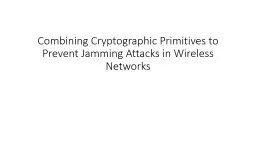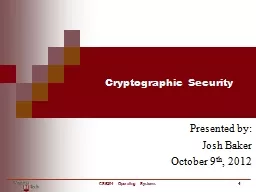PPT-Data Integrity: Applications of Cryptographic
Author : mindeeli | Published Date : 2020-06-23
Hash Functions 1272010 1 Data Integrity Message Authentication Code MAC Cryptographic hash function hKM with two inputs Secret key K Message M Message integrity
Presentation Embed Code
Download Presentation
Download Presentation The PPT/PDF document "Data Integrity: Applications of Crypto..." is the property of its rightful owner. Permission is granted to download and print the materials on this website for personal, non-commercial use only, and to display it on your personal computer provided you do not modify the materials and that you retain all copyright notices contained in the materials. By downloading content from our website, you accept the terms of this agreement.
Data Integrity: Applications of Cryptographic: Transcript
Download Rules Of Document
"Data Integrity: Applications of Cryptographic"The content belongs to its owner. You may download and print it for personal use, without modification, and keep all copyright notices. By downloading, you agree to these terms.
Related Documents














